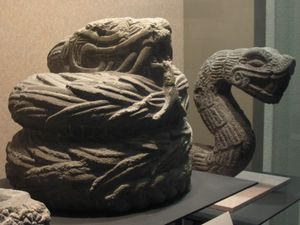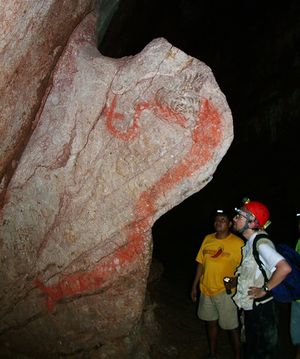الثعبان ذو الريش


Courtesy of Matt Lachniet, used with permission.
The Feathered Serpent was a prominent supernatural entity or deity, found in many Mesoamerican religions. It was called Quetzalcoatl among the Aztecs, Kukulkan among the Yucatec Maya, and Q'uq'umatz and Tohil among the K'iche' Maya. The double symbolism used in its name is considered allegoric to the dual nature of the deity, where being feathered represents its divine nature or ability to fly to reach the skies and being a serpent represents its human nature or ability to creep on the ground among other animals of the Earth, a dualism very common in Mesoamerican deities.[1]
The earliest representations of feathered serpents appear in the Olmec culture (circa 1400-400 BCE).[2] Most surviving representations in Olmec art, such as Monument 19 at La Venta and a painting in the Juxtlahuaca cave (see below), show it as a crested rattlesnake, sometimes with feathers covering the body, and often in close proximity to humans.[3] It is believed that Olmec supernatural entities such as the feathered serpent were the forerunners of many later Mesoamerican deities,[4] although experts disagree on the feathered serpent's importance to the Olmec.[5]
The pantheon of the people of Teotihuacan (200 BCE – 700 CE) also featured a feathered serpent, shown most prominently on the Temple of the Feathered Serpent (dated 150–200 CE).[6] Several feathered serpent representations appear on the building, including full-body profiles and feathered serpent heads.
Buildings in Tula, the capital of the later Toltecs (950–1150 CE), also featured profiles of feathered serpents.[7]
The Aztec feathered serpent god Quetzalcoatl is known from several Aztec codices such as the Florentine codex, as well as from the records of the Spanish conquistadors. Quetzalcoatl was a bringer of knowledge, the inventor of books, and associated with the planet Venus.
The corresponding Mayan god Kukulkan was rare in the Classic era Maya civilization.[8] However, in the Popol Vuh, the K'iche' feathered serpent god Tepeu Q'uq'umatz is the creator of the cosmos.[9]
Along with the feathered serpent deity, several other serpent gods existed in the pantheon of Mesoamerican gods with similar traits.
See also
Notes
- ^ The Oxford Encyclopedia of Mesoamerican Culture
- ^ Pool, p. 1. Other authors give a slightly different dates.
- ^ Joralemon, p. 58.
- ^ Covarrubias, p. 62. Joralemon, p. 58.
- ^ Diehl, p. 104 says that "its rarity suggests that it was a minor member of the Olmec pantheon". Joralemon (1996) however, states that "the feathered serpent is a divinity of considerable importance in Olmec civilization", p. 58.
- ^ Castro.
- ^ Coe, p. 133.
- ^ Miller & Taube, p. 150.
- ^ Christenson (2007)
== المراجع ==
- Castro, Ruben Cabrera (1993) "Human Sacrifice at the Temple of the Feathered Serpent: Recent Discoveries at Teotihuacan" Kathleen Berrin, Esther Pasztory, eds., Teotihuacan, Art from the City of the Gods, Thames and Hudson, Fine Arts Museums of San Francisco, ISBN 0-500-27767-2.
- Coe, Michael D.; Rex Koontz (2002). Mexico: from the Olmecs to the Aztecs (5th edition, revised and enlarged ed.). London and New York: Thames & Hudson. ISBN 0-500-28346-X. OCLC 50131575.
- Covarrubias, Miguel (1957). Indian Art of Mexico and Central America (Color plates and line drawings by the author ed.). New York: Alfred A. Knopf. OCLC 171974.
- Christenson, Allen (2007) [2003]. Popol Vuh: the Sacred Book of the Maya. University of Oklahoma Press. ISBN 978-0-8061-3839-8.
- Diehl, Richard (2004). The Olmecs: America's First Civilization. Ancient peoples and places series. London: Thames & Hudson. ISBN 0-500-02119-8. OCLC 56746987.
- Joralemon, Peter David (1996) "In Search of the Olmec Cosmos: Reconstructing the World View of Mexico's First Civilization", in Olmec Art of Ancient Mexico, eds. E. P. Benson and B. de la Fuente, National Gallery of Art, Washington D.C., ISBN 0-89468-250-4, pp. 51–60.
- Miller, Mary; Karl Taube (1993). The Gods and Symbols of Ancient Mexico and the Maya: An Illustrated Dictionary of Mesoamerican Religion. London: Thames & Hudson. ISBN 0-500-05068-6. OCLC 27667317.7
- Pool, Christopher A. (2007). Olmec Archaeology and Early Mesoamerica. Cambridge World Archaeology. Cambridge and New York: Cambridge University Press. ISBN 978-0-521-78882-3. OCLC 68965709.
للاستزادة
- Bernal, I, Coe, M; et al. (1973). The Iconography of Middle American sculpture. New York: The Metropolitan Museum of Art.
{{cite book}}: Explicit use of et al. in:|author=(help)CS1 maint: extra punctuation (link) CS1 maint: multiple names: authors list (link) (see index)
